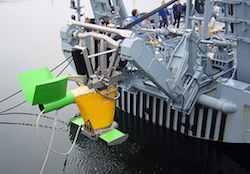 This week the Indian Navy confirmed its purchase of six low-frequency Active Towed Array Sonar (ACTAS) units, for use in tracking Chinese subs in the Indian Ocean. With a stated detection range of 60km (37mi), it appears that this system puts out far less sound than low frequency systems used by the US (SURTASS LFAS) or the British (Sonar 2087), both of which are effective to at least 100 nautical miles, and can be detected at much greater distances. It is remarkably hard to find information about the proliferation of these systems; the German-made ACTAS system is presumably being used elsewhere as well, while the UK Sonar 2087 is deployed on several UK Navy ships, and was recently also purchased by Chilean Navy. So far, the US Navy has plans to outfit 4 ships with its SURTASS LFA system, and it is used regularly in the western Pacific, monitoring Chinese and North Korean activity. While environmental groups continue to challenge US deployment of LFAS and to add biological safeguards to training programs using mid-frequency active sonar (see AEI coverage of both), these and similar systems continue to spread into waters around the world.
This week the Indian Navy confirmed its purchase of six low-frequency Active Towed Array Sonar (ACTAS) units, for use in tracking Chinese subs in the Indian Ocean. With a stated detection range of 60km (37mi), it appears that this system puts out far less sound than low frequency systems used by the US (SURTASS LFAS) or the British (Sonar 2087), both of which are effective to at least 100 nautical miles, and can be detected at much greater distances. It is remarkably hard to find information about the proliferation of these systems; the German-made ACTAS system is presumably being used elsewhere as well, while the UK Sonar 2087 is deployed on several UK Navy ships, and was recently also purchased by Chilean Navy. So far, the US Navy has plans to outfit 4 ships with its SURTASS LFA system, and it is used regularly in the western Pacific, monitoring Chinese and North Korean activity. While environmental groups continue to challenge US deployment of LFAS and to add biological safeguards to training programs using mid-frequency active sonar (see AEI coverage of both), these and similar systems continue to spread into waters around the world.
Jun 02 2015
